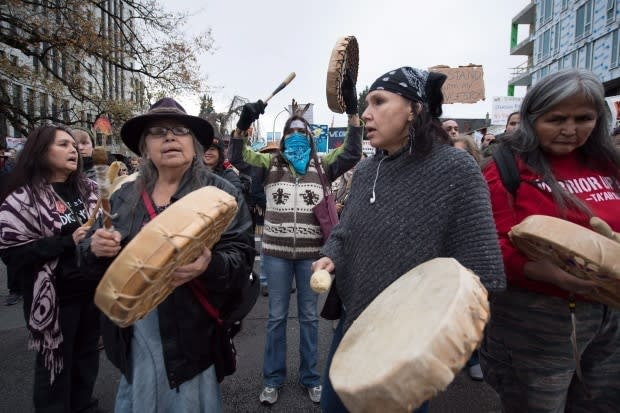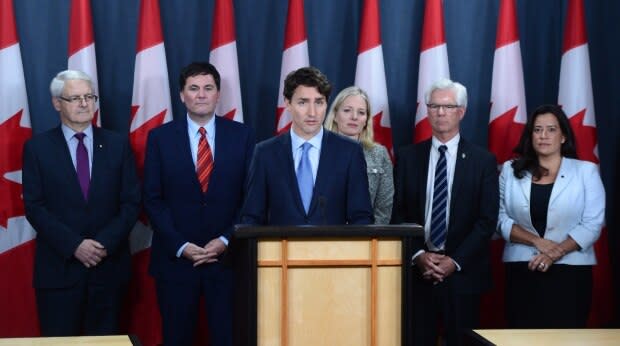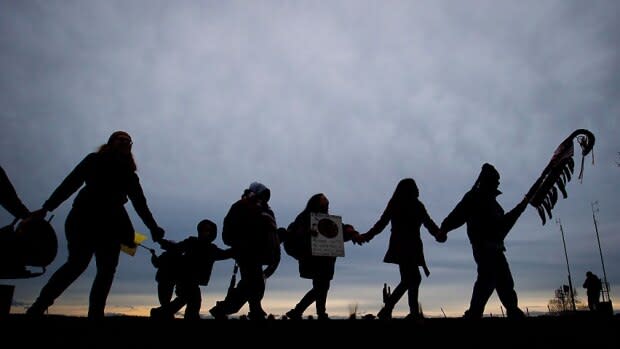RCMP reactivated list of flagged activists days before Trans Mountain decision, documents show
Days before Prime Minister Justin Trudeau announced the initial approval for the Trans Mountain pipeline, the RCMP reactivated a seemingly dormant list of Indigenous rights activists deemed potential "criminal threats," internal RCMP emails and documents show.
An RCMP intelligence initiative called Project Sitka, which concluded in March 2015, identified 89 individuals — Indigenous and non-Indigenous — that the Mounties determined were "willing and capable of utilizing unlawful tactics" during Indigenous rights protests, according to the documents, which include memos, emails and reports, provided to CBC News.
The RCMP launched Project Sitka to get a handle on Indigenous rights-related demonstrations which flared across the country, including Idle No More, from December 2012 until the end of 2013. The RCMP wanted to identify specific activists who had been arrested, arrested and charged and convicted, create profiles and links to organizations across the country. After probing more than 300 activists, the RCMP came up with a list of 89 at the end of the intelligence project.
The documents showing reactivation of the list were obtained by Miles Howe, a cultural studies PhD candidate with Queen's University, through the Access to Information Act.
Please provide any updates to Project Sitka's list of disruptive and volatile subjects from respective divisions - Eric Stubbs in email to all RCMP divisions
The Sitka list had not been updated for over a year when a senior officer sent a request to divisions across the country for new information to add to the existing profiles, days before Trudeau's November 2016 announcement.
"We would like to update and, if required, add to protestor profiles across all divisions to support front-line operations in responding to public order events during protests," said the Nov. 23, 2016, email from Chief Supt. Eric Stubbs, who was then-director general of National Criminal Operations and Contract and Aboriginal Policing.
"Please provide any updates to Project Sitka's list of disruptive and volatile subjects from respective divisions…."

Six days later, on Nov. 29, 2016, Trudeau announced his government had given its initial approval for the Trans Mountain pipeline, which was owned by Kinder Morgan at the time, and for Enbridge's Line 3.
Trudeau also announced the government had rejected Enbridge's Northern Gateway pipeline.
Roughly two weeks before Trudeau's announcement, the RCMP's superintendent responsible for National Security Criminal Operations met with officials from the Canadian Security Intelligence Service, Natural Resources Canada and Justice Canada to discuss "timelines for pipeline decisions," according to a Nov. 14, 2016, email contained in the documents.
The RCMP was also keeping a close eye on anti-Trans Mountain protests at the time. On Nov. 14, 2016, an email circulated listing a number of anti-Trans Mountain vigils planned across the country that was slated for Nov. 21.
Howe said it's clear from the documents that the RCMP reactivated the list of 89.
'Ongoing, updated central list'
"It appears it is an ongoing, updated central list," said Howe, who obtained separate RCMP files showing his name came up during Project Sitka, but was not added to the list.
Howe was involved in Mi'kmaq-led anti-shale gas protests in 2013, but was never convicted of any crimes connected to the demonstrations.
The RCMP said in a statement last week its national criminal intelligence sector no longer maintains the list.
"The RCMP does not currently maintain a list of protester profiles related to any type of public demonstration as part of its national criminal intelligence functions," said the statement.
"The RCMP collects and analyzes information as it relates to criminal activity, regardless of ethnicity, and prepares assessments to inform RCMP management and front-line police officers about emerging threats."
Project recommended maintaining activists list
Project Sitka had recommended that Indigenous rights protests be reclassified separately from their previous categorization under the terrorism-extremism umbrella because of their unique historical roots in unresolved land claims and rights issues.
It also recommended that RCMP divisions maintain and feed into a central database of activists deemed potential criminal threats that would be available to front-line officers facing Indigenous rights protests.
The email traffic shows that the RCMP were dealing with Sitka on two tracks in November 2016, said Jeffery Monaghan, an associate professor of criminology at Carleton University who obtained the original Sitka report, along with researcher Andy Crosby, in 2016 under the Access to Information Act.
On one track, senior officers, including input from then-RCMP commissioner Robert Paulson, were drafting media lines in response to a news report about the project, trying to play down Sitka by emphasizing the project was over and that it did not target Indigenous people, he said.
On the other track, officers involved in federal policing were moving to reactivate elements of Sitka as the federal government prepared to announce its initial approval of Trans Mountain, he said.
"These meetings are happening about pipeline announcements," said Monaghan.
"They decided that it might be worthwhile, all of a sudden, out of the blue, re-kickstarting it and updating these profiles ... which is too much to simply be a coincidence."

The email thread begins when Stubbs was tasked by a deputy commissioner on Nov. 9, 2016, to provide superiors with an update on Sitka, according to internal emails.
The request came a day after Aboriginal Peoples Television Network reported on the existence of the Project Sitka intelligence project which created the list of activists.
Stubbs seemed unclear about the status of the list and wrote in an email that he was surprised to find out his unit was responsible for maintaining the list, which hadn't been updated in months.
"Yesterday, there was an article in the media about this. Now, we're looking at the project. ... It doesn't appear that much has been done to maintain the list," wrote Stubbs.
"Deputy commissioner ... is asking to be updated on the project … Can you shed some light on where this went when it came to us? I find it odd that we would take this on given the lack of infrastructure in our unit."
Stubbs received a response saying that "divisions were supposed to continue to feed into the file."
Told media Sitka did not 'target Indigenous protests'
The RCMP then received a number of media requests about Sitka and began developing media lines and draft responses to give to federal ministers in question period about the project.
A Nov. 15, 2016, email thread shows that the media response went through Paulson's office, who requested a specific line be added that ended up at the top of the final media statement.
"Sitka was designed in order to separate and protect the people's fundamental right to protest and to provide the capacity for the police to investigate criminal conduct," said the first line.
The statement also said the RCMP "did not specifically target Indigenous protests" and that "Project Sitka is now concluded."
At the same time, emails show that senior RCMP officers continued to discuss and meet on moving on some of Sitka's recommendations. This led to the decision to issue a division-wide request for information to update the Sitka list of flagged activists.
The wording of the request, which was sent out by Stubbs, was drafted with input from Supt. Marie-Claude Arsenault with the National Intelligence Co-ordination Centre, according to an email thread that ran between Nov. 21-22, 2016.
"We must have a clear message that the focus is on Aboriginal protests (not Aboriginal protesters) as per Sitka's objectives," wrote Arsenault on Nov. 21.
Project Sitka was led by the National Intelligence Co-ordinating Centre with support from what was then known as Community and Aboriginal Policing in 2014. The focus for the intelligence centre that fiscal year was "Aboriginal public order events," according to a briefing note contained in the documents.
Many activists from B.C.
The previous year had seen the Idle No More Indigenous rights movement sweep the country followed by anti-shale gas protests in New Brunswick around the Mi'kmaq First Nation of Elsipogtog, which saw several RCMP vehicles set on fire during one clash.
The RCMP had no centralized process for dealing with Indigenous rights protests at the time after disbanding the Aboriginal Joint Intelligence Group in 2010, according to the briefing note.

Of the 89 individuals identified in the Sitka report, 16 came from British Columbia and several on the list were also connected to a camp set up by the Wet'suwet'en nation to block pipelines from crossing their territory.
Last January, the RCMP arrested 14 people in B.C. after raiding a fortified checkpoint set up by Wet'suwet'en nation members against the Coastal GasLink natural gas pipeline.
Monaghan said the Sitka list was designed to be available for front-line officers dealing with Indigenous rights protest. He said the criteria the RCMP used to place people on the list may over-dramatize the actual threat an activist poses.
"Their evaluation of volatility or disruptive has to do with what they call background, motivation and rhetoric and the networks you have, associations and mobility, things protected by the Charter," Monaghan said.
"Things we do — talk to people, meet with people, or engage in digital communication with people — all that stuff is being gathered by the police to gauge what kinds of personality these people are."
"Where you start having situations where police officers are told ahead of time that their safety is at risk, that there are volatile activists, the chances of de-escalation are dramatically reduced," he said.


